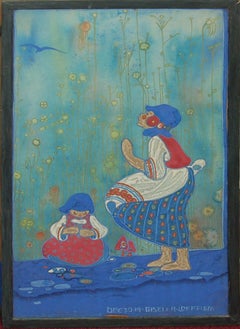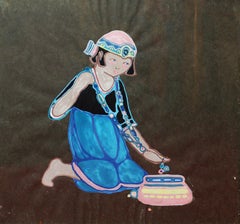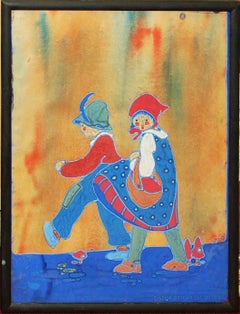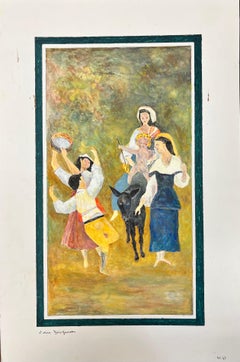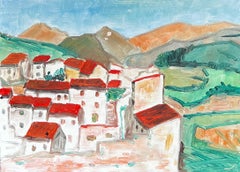Gisella Loeffler Art
American, Austrian, 1902-1977
Born in Austria, Gisella came to the United States with her family in 1908, settling in St. Louis, MO. After studying art at Washington University in St. Louis, she became a prominent member of the local art community, joining the St. Louis Art Guild as well as the Boston Society of Arts and Crafts. In addition to creating posters for the St. Louis Post Dispatch, Gisella won prizes from the Artists Guild of the Author’s League of America in 1919 and 1920 and from the Kansas City Art Institute in 1923. She also began working in textiles, including batik, to which she would return later in her career.
Having seen a local exhibition of paintings by Taos artists Oscar Berninghaus (who was from St. Louis) and Ernest Blumenschein, Gisella felt drawn to Taos, which reminded her of the villages of her native Austria. In 1933 the single mother with two daughters, Undine and Aithra, moved to Taos, where she lived off and on for the rest of her life. She traveled frequently, spending extended periods in Mexico, South America, and California, but always returned to New Mexico.
Gisella initially applied an Austro-Hungarian folk-art style to the Indian and Hispanic subjects that she found in New Mexico. In her early work she covered her surfaces with decorative floral and faunal motifs, and her images were flat with no attempt at rendering traditional one-point perspective. Eventually, though, Gisella developed her own style, often using children or childlike figures as subjects. Still, the influence of her native country’s folk art remained evident in her New Mexican, Mexican, and South American images.
In California, Gisella broadened her range of artistic pursuits. She taught art privately, created illustrations for Scripts Magazine, and did interior design for private homes. She also designed greeting cards, a practice she continued after her return to New Mexico, where she created a series of Christmas cards.
Gisella began illustrating children’s books in 1941 when she collaborated on Franzi and Gizi with author Margery Bianco. Eventually she wrote and illustrated her own book, El Ekeko, in 1964. She also designed ceramics—her Happy Time Dinnerware, marketed by Poppy Trail and manufactured by Metlox of Manhattan Beach, CA, is highly collectible today.
As a painter, she worked on canvas or paper in oil, casein, and watercolor. She also painted furniture. Besides making her own clothing, Gisella worked in other fabric arts such as batik and embroidery. In fact, she received the top award in fabric arts in 1959 and again in 1967 from the Mus-eum of International Folk Art in Santa Fe. But perhaps Gisella’s greatest legacy is the murals she painted for children’s areas in hospitals across the United States.
Gisella’s death in 1977 left a large hole in the fabric of the Taos Art Colony and the entire Taos community. Yet her work, so colorful and full of joy, remains an uplifting presence in Taos.(Biography provided by Gallery of the Masters)
4
3
1
2
2
Overall Height
to
Overall Width
to
4
4
4
2
2
2
1
1
1
1
1
4
4
4
6,998
3,352
2,513
1,213
4
4
4
Artist: Gisella Loeffler
Mother and Child In the Garden
By Gisella Loeffler
Located in Missouri, MO
Gisella Loeffler
"Mother and Child in the Gardenl" 1919
Gouache on Paper
Initialed Lower Right
Framed Size: approx 19 x 10 3/4 inches
In a village filled with colorful characters, few Taos artists were as colorful as Gisella Loeffler [1900-1977]. From her handmade Austrian clothing and hand-painted furniture to whimsical paintings and letters written in multicolored crayon, joyful color defined the artist, who early on chose to use simply Gisella as her professional name and was known as such to everyone in Taos.
In spite of her fame there—the Taos News once labeled her a Taos legend—Gisella is rarely included in scholarly discussions of the Taos Art Colony. This oversight is likely due to the naive quality of her work, in which children or childlike adults inhabit a simple, brightly colored world filled with happiness. The macabre, the sad, the tortured, the offensive—all have no place in Gisella’s paintings. Her naive style of work looks very different from that of the better-known early Taos artists. Yet both Gisella’s artwork and her interesting life command attention.
Born in Austria, Gisella came to the United States with her family in 1908, settling in St. Louis, MO. After studying art at Washington University in St. Louis, she became a prominent member of the local art community, joining the St. Louis Art Guild as well as the Boston Society of Arts and Crafts. In addition to creating posters for the St. Louis Post Dispatch, Gisella won prizes from the Artists Guild of the Author’s League of America in 1919 and 1920 and from the Kansas City Art Institute in 1923. She also began working in textiles, including batik, to which she would return later in her career.
In the early 1920s Gisella married writer and music critic Edgar Lacher. A difficult character, Lacher may have chafed under Gisella’s success, for the couple divorced in the 1930s.
Having seen a local exhibition of paintings by Taos artists Oscar Berninghaus (who was from St. Louis) and Ernest Blumenschein, Gisella felt drawn to Taos, which reminded her of the villages of her native Austria. In 1933 the single mother with two daughters, Undine and Aithra, moved to Taos, where she lived off and on for the rest of her life. She traveled frequently, spending extended periods in Mexico, South America, and California, but always returned to New Mexico.
Gisella initially applied an Austro-Hungarian folk-art style to the Indian and Hispanic subjects that she found in New Mexico. In her early work she covered her surfaces with decorative floral and faunal motifs, and her images were flat with no attempt at rendering traditional one-point perspective. Eventually, though, Gisella developed her own style, often using children or childlike figures as subjects. Still, the influence of her native country’s folk art remained evident in her New Mexican, Mexican, and South American images.
In 1938 Gisella moved briefly to Los Griegos, north of Albuquerque, to be closer to medical facilities for her eldest daughter, who was suffering from rheumatic fever. Two years later, she moved to California to participate in the war effort, painting camouflage and decals on airplanes for Lockheed.
In California, Gisella broadened her range of artistic pursuits. She taught art privately, created illustrations for Scripts Magazine, and did interior design for private homes. She also designed greeting cards, a practice she continued after her return to New Mexico, where she created a series of Christmas cards.
Gisella began illustrating children’s books in 1941 when she collaborated on Franzi and Gizi with author Margery Bianco. Eventually she wrote and illustrated her own book, El Ekeko, in 1964. She also designed ceramics—her Happy Time Dinnerware, marketed by Poppy Trail...
Category
1910s Modern Gisella Loeffler Art
Materials
Gouache
Three Girls
By Gisella Loeffler
Located in Missouri, MO
Gisella Loeffler
"Three Girlsl" c. 1919
Gouache on Paper
Initialed Lower Left
Framed Size: approx 19 x 13 inches
In a village filled with colorful characters, few Taos artists were as colorful as Gisella Loeffler [1900-1977]. From her handmade Austrian clothing and hand-painted furniture to whimsical paintings and letters written in multicolored crayon, joyful color defined the artist, who early on chose to use simply Gisella as her professional name and was known as such to everyone in Taos.
In spite of her fame there—the Taos News once labeled her a Taos legend—Gisella is rarely included in scholarly discussions of the Taos Art Colony. This oversight is likely due to the naive quality of her work, in which children or childlike adults inhabit a simple, brightly colored world filled with happiness. The macabre, the sad, the tortured, the offensive—all have no place in Gisella’s paintings. Her naive style of work looks very different from that of the better-known early Taos artists. Yet both Gisella’s artwork and her interesting life command attention.
Born in Austria, Gisella came to the United States with her family in 1908, settling in St. Louis, MO. After studying art at Washington University in St. Louis, she became a prominent member of the local art community, joining the St. Louis Art Guild as well as the Boston Society of Arts and Crafts. In addition to creating posters for the St. Louis Post Dispatch, Gisella won prizes from the Artists Guild of the Author’s League of America in 1919 and 1920 and from the Kansas City Art Institute in 1923. She also began working in textiles, including batik, to which she would return later in her career.
In the early 1920s Gisella married writer and music critic Edgar Lacher. A difficult character, Lacher may have chafed under Gisella’s success, for the couple divorced in the 1930s.
Having seen a local exhibition of paintings by Taos artists Oscar Berninghaus (who was from St. Louis) and Ernest Blumenschein, Gisella felt drawn to Taos, which reminded her of the villages of her native Austria. In 1933 the single mother with two daughters, Undine and Aithra, moved to Taos, where she lived off and on for the rest of her life. She traveled frequently, spending extended periods in Mexico, South America, and California, but always returned to New Mexico.
Gisella initially applied an Austro-Hungarian folk-art style to the Indian and Hispanic subjects that she found in New Mexico. In her early work she covered her surfaces with decorative floral and faunal motifs, and her images were flat with no attempt at rendering traditional one-point perspective. Eventually, though, Gisella developed her own style, often using children or childlike figures as subjects. Still, the influence of her native country’s folk art remained evident in her New Mexican, Mexican, and South American images.
In 1938 Gisella moved briefly to Los Griegos, north of Albuquerque, to be closer to medical facilities for her eldest daughter, who was suffering from rheumatic fever. Two years later, she moved to California to participate in the war effort, painting camouflage and decals on airplanes for Lockheed.
In California, Gisella broadened her range of artistic pursuits. She taught art privately, created illustrations for Scripts Magazine, and did interior design for private homes. She also designed greeting cards, a practice she continued after her return to New Mexico, where she created a series of Christmas cards.
Gisella began illustrating children’s books in 1941 when she collaborated on Franzi and Gizi with author Margery Bianco. Eventually she wrote and illustrated her own book, El Ekeko, in 1964. She also designed ceramics—her Happy Time Dinnerware, marketed by Poppy Trail...
Category
1910s Modern Gisella Loeffler Art
Materials
Gouache
The Necklace and the Pot
By Gisella Loeffler
Located in Missouri, MO
Gisella Loeffler
"The Necklace and the Pot" c. 1919
Gouache on Paper
Initialed Lower Left
Framed Size: approx 15 x 15 inches
In a village filled with colorful characters, few Taos artists were as colorful as Gisella Loeffler [1900-1977]. From her handmade Austrian clothing and hand-painted furniture to whimsical paintings and letters written in multicolored crayon, joyful color defined the artist, who early on chose to use simply Gisella as her professional name and was known as such to everyone in Taos.
In spite of her fame there—the Taos News once labeled her a Taos legend—Gisella is rarely included in scholarly discussions of the Taos Art Colony. This oversight is likely due to the naive quality of her work, in which children or childlike adults inhabit a simple, brightly colored world filled with happiness. The macabre, the sad, the tortured, the offensive—all have no place in Gisella’s paintings. Her naive style of work looks very different from that of the better-known early Taos artists. Yet both Gisella’s artwork and her interesting life command attention.
Born in Austria, Gisella came to the United States with her family in 1908, settling in St. Louis, MO. After studying art at Washington University in St. Louis, she became a prominent member of the local art community, joining the St. Louis Art Guild as well as the Boston Society of Arts and Crafts. In addition to creating posters for the St. Louis Post Dispatch, Gisella won prizes from the Artists Guild of the Author’s League of America in 1919 and 1920 and from the Kansas City Art Institute in 1923. She also began working in textiles, including batik, to which she would return later in her career.
In the early 1920s Gisella married writer and music critic Edgar Lacher. A difficult character, Lacher may have chafed under Gisella’s success, for the couple divorced in the 1930s.
Having seen a local exhibition of paintings by Taos artists Oscar Berninghaus (who was from St. Louis) and Ernest Blumenschein, Gisella felt drawn to Taos, which reminded her of the villages of her native Austria. In 1933 the single mother with two daughters, Undine and Aithra, moved to Taos, where she lived off and on for the rest of her life. She traveled frequently, spending extended periods in Mexico, South America, and California, but always returned to New Mexico.
Gisella initially applied an Austro-Hungarian folk-art style to the Indian and Hispanic subjects that she found in New Mexico. In her early work she covered her surfaces with decorative floral and faunal motifs, and her images were flat with no attempt at rendering traditional one-point perspective. Eventually, though, Gisella developed her own style, often using children or childlike figures as subjects. Still, the influence of her native country’s folk art remained evident in her New Mexican, Mexican, and South American images.
In 1938 Gisella moved briefly to Los Griegos, north of Albuquerque, to be closer to medical facilities for her eldest daughter, who was suffering from rheumatic fever. Two years later, she moved to California to participate in the war effort, painting camouflage and decals on airplanes for Lockheed.
In California, Gisella broadened her range of artistic pursuits. She taught art privately, created illustrations for Scripts Magazine, and did interior design for private homes. She also designed greeting cards, a practice she continued after her return to New Mexico, where she created a series of Christmas cards.
Gisella began illustrating children’s books in 1941 when she collaborated on Franzi and Gizi with author Margery Bianco. Eventually she wrote and illustrated her own book, El Ekeko, in 1964. She also designed ceramics—her Happy Time Dinnerware, marketed by Poppy Trail...
Category
1910s Modern Gisella Loeffler Art
Materials
Gouache
Going for a Stroll
By Gisella Loeffler
Located in Missouri, MO
Gisella Loeffler
"Going for a Stroll" c. 1919
Gouache on Paper
Initialed
Framed Size: approx 17 x 13 inches
In a village filled with colorful characters, few Taos artists were as colorful as Gisella Loeffler [1900-1977]. From her handmade Austrian clothing and hand-painted furniture to whimsical paintings and letters written in multicolored crayon, joyful color defined the artist, who early on chose to use simply Gisella as her professional name and was known as such to everyone in Taos.
In spite of her fame there—the Taos News once labeled her a Taos legend—Gisella is rarely included in scholarly discussions of the Taos Art Colony. This oversight is likely due to the naive quality of her work, in which children or childlike adults inhabit a simple, brightly colored world filled with happiness. The macabre, the sad, the tortured, the offensive—all have no place in Gisella’s paintings. Her naive style of work looks very different from that of the better-known early Taos artists. Yet both Gisella’s artwork and her interesting life command attention.
Born in Austria, Gisella came to the United States with her family in 1908, settling in St. Louis, MO. After studying art at Washington University in St. Louis, she became a prominent member of the local art community, joining the St. Louis Art Guild as well as the Boston Society of Arts and Crafts. In addition to creating posters for the St. Louis Post Dispatch, Gisella won prizes from the Artists Guild of the Author’s League of America in 1919 and 1920 and from the Kansas City Art Institute in 1923. She also began working in textiles, including batik, to which she would return later in her career.
In the early 1920s Gisella married writer and music critic Edgar Lacher. A difficult character, Lacher may have chafed under Gisella’s success, for the couple divorced in the 1930s.
Having seen a local exhibition of paintings by Taos artists Oscar Berninghaus (who was from St. Louis) and Ernest Blumenschein, Gisella felt drawn to Taos, which reminded her of the villages of her native Austria. In 1933 the single mother with two daughters, Undine and Aithra, moved to Taos, where she lived off and on for the rest of her life. She traveled frequently, spending extended periods in Mexico, South America, and California, but always returned to New Mexico.
Gisella initially applied an Austro-Hungarian folk-art style to the Indian and Hispanic subjects that she found in New Mexico. In her early work she covered her surfaces with decorative floral and faunal motifs, and her images were flat with no attempt at rendering traditional one-point perspective. Eventually, though, Gisella developed her own style, often using children or childlike figures as subjects. Still, the influence of her native country’s folk art remained evident in her New Mexican, Mexican, and South American images.
In 1938 Gisella moved briefly to Los Griegos, north of Albuquerque, to be closer to medical facilities for her eldest daughter, who was suffering from rheumatic fever. Two years later, she moved to California to participate in the war effort, painting camouflage and decals on airplanes for Lockheed.
In California, Gisella broadened her range of artistic pursuits. She taught art privately, created illustrations for Scripts Magazine, and did interior design for private homes. She also designed greeting cards, a practice she continued after her return to New Mexico, where she created a series of Christmas cards.
Gisella began illustrating children’s books in 1941 when she collaborated on Franzi and Gizi with author Margery Bianco. Eventually she wrote and illustrated her own book, El Ekeko, in 1964. She also designed ceramics—her Happy Time Dinnerware, marketed by Poppy Trail...
Category
1910s Modern Gisella Loeffler Art
Materials
Gouache
Related Items
1950's Modernist/ Cubist Painting - Figures Celebrating Life
By Bernard Labbe
Located in Cirencester, Gloucestershire
French Figures
by Bernard Labbe (French mid 20th century)
original gouache on card
size: 19.5 x 13 inches
condition: very good and ready to be enjoyed
...
Category
Mid-20th Century Modern Gisella Loeffler Art
Materials
Gouache
1950's Modernist/ Cubist Painting - Red Roof Green Landscape
By Bernard Labbe
Located in Cirencester, Gloucestershire
French Landscape
by Bernard Labbe (French mid 20th century)
original gouache on board unframed
size: 9.5 x 13 inches
condition: very good and ready to be enjoyed
provenance: the art...
Category
Mid-20th Century Modern Gisella Loeffler Art
Materials
Gouache
African American Woman artist Mailou Jones Cezannian Cote d'Azur cubist village
Located in Norwich, GB
If you are interested in African American Art and in Women in the Arts, I will certainly not need to introduce Lois Mailou Jones (1905-1988). Often associated with the Harlem Renaiss...
Category
Mid-19th Century American Modern Gisella Loeffler Art
Materials
Watercolor, Gouache, Handmade Paper
H 29.93 in W 25.79 in D 1.19 in
Jacques Thevenet (1891-1989) Portrait of a man in the studio, signed Gouache
By Jacques Thévenet
Located in Paris, FR
Jacques Thevenet (1891-1989)
Portrait of a man in the studio
Gouache on paper
Signed lower right
64 x 49 cm
Framed 77 x 62 cm, some damages to the frame as visible on the photographs
Jacques Thévenet was born in Montquinon 17 October 1891, in the family’s ancestral home, built by his great grand-father, Auguste Hugues Claude Thévenet, lawyer from Château-Chinon.
He had 3 sisters and lost his mother in 1895 when he was only four. His father Louis moved the family to Paris where he run a law practice.
Young Jacques studied at the Lycée Carnot and later attended the École de droit of the Sorbonne University. Simultaneously, he attended the Académie Julian, with several painters such as Amédée de la Patellière, Jean Crotti...
Category
1960s Modern Gisella Loeffler Art
Materials
Gouache
“Woman in Blue”
By Kenneth Paul Block
Located in Southampton, NY
Here for your consideration is an original watercolor and gouache fashion illustration by the world renowned fashion artist, Kenneth Paul Block. Presently unframed. Signed with initi...
Category
1960s American Modern Gisella Loeffler Art
Materials
Watercolor, Gouache, Archival Paper
Place de la Concorde by Jean Dufy - Mixed media on paper, Parisian scene
By Jean Dufy
Located in London, GB
*UK BUYERS WILL PAY AN ADDITIONAL 5% IMPORT DUTY ON TOP OF THE ABOVE PRICE
Place de la Concorde by Jean Dufy (1888-1964)
Gouache and watercolour on paper
48.6 x 63.2 cm (19 ¹/₈ x 24 ⁷/₈ inches)
Signed lower right, Jean Dufy
Executed circa 1955
This work is accompagnied by a certificate of authenticity signed by Jacques Bailly and will be included in the forthcoming Catalogue Raisonné vol.3 currently being prepared by Jacques Bailly.
Provenance: Private collection, France
Artist biography:
Born into a large family in the busy port-city of La Havre in northern France, Jean Dufy was the younger brother of the Fauvist painter Raoul Dufy. In order to please his accountant father, Jean was...
Category
1950s Modern Gisella Loeffler Art
Materials
Paper, Watercolor, Gouache
BYE BYE BIRDIE Original 1960 Broadway Musical Costume Drawing Tony Award Elvis
Located in New York, NY
BYE BYE BIRDIE Original 1960 Broadway Musical Costume Drawing Tony Award Elvis.
Miles White (1915 – 2000)
BYE BYE BIRDIE
11 x 8 inches
Mixed Media on...
Category
1960s American Modern Gisella Loeffler Art
Materials
Watercolor, Gouache, Pencil
Glassblowers WPA American Scene Mid- 20th Century Modern Figurative Workers 1932
By Harry Gottlieb
Located in New York, NY
Glassblowers WPA American Scene Mid- 20th Century Modern Figurative Workers. Dated and signed "32 Harry Gottlieb" lower right. Sight: 13 1/8" H x 18 1/4" W.
Harry Gottlieb, painter, screenprinter, educator, and lithographer, was born in Bucharest, Rumania. He emigrated to America in 1907, and his family settled in Minneapolis. From 1915 to 1917, Gottlieb attended the Minneapolis Institute of Arts. After a short stint as an illustrator for the U.S. Navy, Gottlieb moved to New York City; he became a scenic and costume designer for Eugene O"Neill's Provincetown Theater Group. He also studied at the Philadelphia Academy of Fine Arts and the National Academy of Design.
He was one of America's first Social Realist painters, influenced by that Robert Henri-led movement in New York City where Gottlieb settled in 1918. He was also a pioneer in screen printing, which he learned while working for the WPA. He married Eugenie Gershoy, and the couple joined the artist colony at Woodstock, New York. He lectured widely on art education.
In 1923, Gottlieb settled in Woodstock, New York and in 1931, spent a a year abroad studying under a Guggenheim Fellowship.
In 1935, he joined the Federal Art Project...
Category
1930s American Modern Gisella Loeffler Art
Materials
Paper, Gouache
Yiddish Theatre Cubist Costume Design 1924 Deco Color Field Modernism Broadway
Located in New York, NY
Yiddish Theatre Cubist Costume Design 1924 Deco Color Field Modernism Broadway.
Boris Aronson (1898 – 1980) "Day and Night," 17 ½ x 13 inches. Gouache ...
Category
1920s American Modern Gisella Loeffler Art
Materials
Paper, Watercolor, Gouache
Americana, Lawyer in Court, Politician, Gouache Painting WPA Art William Gropper
By William Gropper
Located in Surfside, FL
William Gropper Original Gouache on Paper
Hand signed lower right
33.5 x 27.5 image 26 x 20.5
The New-York born artist William Gropper was a painter and cartoonist who, with caricature style, focused on social concerns, and was actively engaged in support of the organized labor movement throughout his career. This original watercolor drawing is done in the iconic style of the artist's oeuvre.
Born to Harry and Jenny Gropper in 1897, William was raised in New York City's Lower East Side. His parents were Jewish immigrants from Romania and Ukraine, and young William grew up in relative poverty, watching his family struggle to achieve that sought-after American dream. His father, a bright and college-educated man, was unable to find employment that worthy of his intellect. His mother, meanwhile, worked as a seamstress from home. Coupled with the devastating loss of an aunt to the infamous Triangle Factory fire of 1911, significant childhood factors created the foundation that led to Gropper’s exploration of the American experience.
Early on, Gropper displayed an extraordinary, natural skill for art. By 1912, he was already studying under the instruction of George Bellows and Robert Henri at the Ferrer School in Greenwich Village. During his time at school, Gropper was also awarded a prestigious scholarship to study at the National Academy of Design. However, he refused to fit into convention and was swiftly expelled from the Academy. After his expulsion, Gropper returned home to help financially by assisting his mother and taking a shop position. However, he didn't abandon art academia and soon presented a portfolio to the New York School of Fine Art which earned him a scholarship for study.
Gropper obtained his first significant job as a cartoonist for the New York Tribune in 1917. While working as a staff cartoonist for the Tribune, he also contributed drawings to publications like Vanity Fair, New Masses, The Nation, and Freiheit. His interest in the welfare of the American worker, class inequality, and social injustice was central in his work. After publishing the graphic novel Alley Oop in 1930, Gropper's illustration career extended well into the decade. However, he was never exempt from controversy, and his 1935 Vanity Fair cartoon; prompted anger from the Japanese government.
As an involved labor organizer and Social Realist activist, Gropper continued to bring attention to his radical reputation with visits to the Soviet Union and Poland. However, his concern with European politics and U.S. social causes didn't slow down his artistic career, and by the late 1930s, he had produced significant murals for American cities like Washington D.C. His 1938 mural Construction of a Dam was commissioned for the Department of the Interior and represents the Social-Realism style that depicts experiences of the worker and everyday societal life. Measuring at a staggering 27ft by 87ft, the piece portrays muscular, robust American laborers scaling rocky hillsides, building infrastructure, and operating heavy machinery. The mural feels undeniably American with golden scenery, denim blues, and steely gray colors. Gropper fits perfectly into Social-Realism because the style exhibits an illustrative flair with strong lines and simple, bold hues.
The inspiration for Construction of a Dam sprang from his 1937 travels to the poverty-stricken Dust Bowl area. The trip was sponsored by a Guggenheim Foundation Fellowship, and his drawings of the Grand Coulee and Boulder Dams...
Category
Mid-20th Century Modern Gisella Loeffler Art
Materials
Ink, Watercolor, Gouache
Two Dueñas.
By Donn Russell
Located in Storrs, CT
Two Dueñas. c. 1960. Watercolor and gouache. 13 x 17. Signed and annotated 'SPAIN' lower right. Housed in a 21 x 25-inch black wood frame.
Donn Russell is one of Nantucket Island's...
Category
1950s American Modern Gisella Loeffler Art
Materials
Watercolor, Gouache
Haitian Scene #7 Mid Century modern painting by renowned artist, signed AA label
By Adolf Dehn
Located in New York, NY
Adolf Arthur Dehn
Haitian Scene #7, ca. 1951
Watercolor gouache, hand signed; framed with AAA Gallery label verso
Signed on the front bearing the origina...
Category
Mid-20th Century Modern Gisella Loeffler Art
Materials
Watercolor, Gouache, Mixed Media
H 13.25 in W 11.25 in D 0.5 in
Gisella Loeffler art for sale on 1stDibs.
Find a wide variety of authentic Gisella Loeffler art available for sale on 1stDibs. If you’re browsing the collection of art to introduce a pop of color in a neutral corner of your living room or bedroom, you can find work that includes elements of blue and other colors. You can also browse by medium to find art by Gisella Loeffler in gouache, paint, watercolor and more. Much of the original work by this artist or collective was created during the 1910s and is mostly associated with the modern style. Not every interior allows for large Gisella Loeffler art, so small editions measuring 11 inches across are available. Customers who are interested in this artist might also find the work of Daniel Ginsbourg, Jane Levy, and Florence E. Nosworthy.
Artists Similar to Gisella Loeffler
Robert Sargent Austin, R.A., P.R.E., P.R.W.S.
